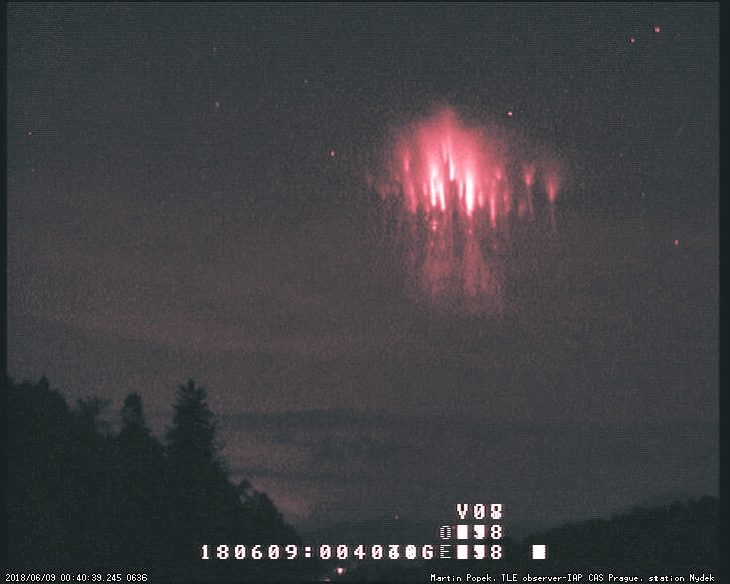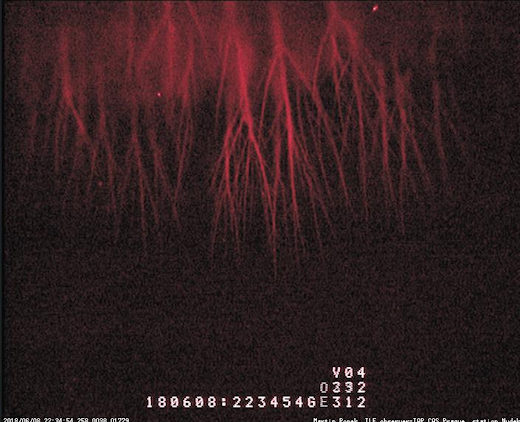
© Martin PopekRed Sprites June 8, 2018 @ Nýdek, Czech republic
Sprite lightning storm over EuropeThis weekend, a powerful mesoscale convective system (MSC) of thunderstorms over central Europe produced a furious outburst of sprites. "It was unreal," says Martin Popek of Nýdek, Czechia, a veteran photographer of the
upward directed bolts.
"I recorded more than 250 sprites in only 4.5 hours of observation! That's nearly as many as I typically see in the entire summer thunderstorm season."This is a
jellyfish sprite--so called because it resembles the eponymous sea creature. Jellyfish sprites are typically very large, stretching as much as 50 km between the tops of their heads to the tips of their tentacles below. "Regular jellyfish sprites are associated with very strong positive cloud-to-ground lightning strokes in the underlying convective storms," notes lightning scientist Oscar van der Velde of the Technical University of Catalonia, Spain.
However,
not all of the jellyfish were regular. Some were "decapitated"--without heads. "I recorded about 20 sets of tentacles only," says Popek.
Here is one example
of many:

© Martin Popek

© Martin PopekRed Sprites June 8, 2018 @ Nýdek, Czech republic
"In my experience, this is quite rare," he adds.
"It is rare," agrees van der Velde.
"We don't know why they sometimes look like this." He speculates that atmospheric waves called "gravity waves" sometimes interfere with the normal formation of jellyfish, leaving them headless. "
Mesospheric gravity waves likely help focus the electric field to trigger downward streamers," he says. "But note that
sprite morphology is not fully understood--not even for regular jellyfish. We have a lot to learn."
Another observer in the Czech Republic, Daniel Ščerba-Elza, also photographed the display. "It was extremely active," says Ščerba-Elza. "I recorded about 69 sprites,
much more than usual. The storms were about 250 - 300 km away in Austria and Hungary. This is a good distance because it allows you to see
over the tops of the thunderheads." He made a
summary video of the outburst.
Such an outburst
before summer even begins may be a good omen for sprite photographers as thunderstorm season gains steam. Stay tuned for more sightings.
Global cosmic radiation measurementsFor the past two years, Spaceweather.com and the students of Earth to Sky Calculus have been traveling around the world, launching
cosmic ray balloons to map our planet's radiation environment. Our sensors travel from ground level to the stratosphere and bring their data back to Earth by parachute. Here is a plot showing radiation vs. altitude in Norway, Chile, Mexico, and selected locations in the USA:
Note: Data from Sweden and several other US states are omitted for the clarity of the plot.
We're about to
add a new country to the list: New Zealand. On June 18th, a team of
students from Earth to Sky is traveling to New Zealand's north island to launch 3 cosmic ray balloons in only 10 days. Soon, we will know more about cosmic rays above Earth's 8th continent.Cosmic rays are, essentially, the subatomic debris of dying stars, accelerated to nearly light speed by supernova explosions. They travel across space and approach Earth from all directions, peppering our planet 24/7. When cosmic rays crash into Earth's atmosphere,
they produce a spray of secondary particles and photons that is most intense at the entrance to the stratosphere. This secondary spray is what we measure.
The purpose of our mapping project is to study how well Earth's atmosphere and magnetic field protects us from cosmic rays. As the plot shows, the shielding is uneven.
More radiation gets through to the poles (e.g., Norway) and less radiation penetrates near the equator (e.g., Mexico).
But there's more to the story. Our launch sites in
Chile and California are equidistant from the equator, yet their radiation profiles are sharply different. Chile is on the verge of the
South Atlantic Anomaly, which almost surely distorts the radiation field there. Our flights over New Zealand may shed some light on this, because our launch sites in New Zealand will be the same distance from the equator as the sites in Chile. Stay tuned!
Technical note: The radiation sensors onboard our helium balloons detect X-rays and gamma-rays in the energy range 10 keV to 20 MeV.
These energies span the range of medical X-ray machines and airport security scanners.
Cosmic rays in the atmosphereReaders, thank you for your patience while we continue to develop this new section of Spaceweather.com. We've been working to streamline our data reduction, allowing us to post results from balloon flights much more rapidly, and we have developed a new data product, shown here:
This plot displays radiation measurements not only in the stratosphere, but also at aviation altitudes. Dose rates are expessed as multiples of sea level. For instance, we see that boarding a plane that flies at 25,000 feet exposes passengers to dose rates ~10x higher than sea level. At 40,000 feet, the multiplier is closer to 50x. These measurements are made by our usual cosmic ray payload as it passes through aviation altitudes en route to the stratosphere over California.
What is this all about?Approximately once a week, Spaceweather.com and the students of
Earth to Sky Calculus fly space weather balloons to the stratosphere over California. These balloons are equipped with radiation sensors that detect cosmic rays, a surprisingly "down to Earth" form of space weather. Cosmic rays can
seed clouds,
trigger lightning, and
penetrate commercial airplanes. Furthermore, there are studies (
#1,
#2,
#3,
#4) linking cosmic rays with cardiac arrhythmias and sudden cardiac death in the general population.
Our latest measurements show that cosmic rays are intensifying, with an increase of more than 13% since 2015:
Why are cosmic rays intensifying? The main reason is the sun. Solar storm clouds such as coronal mass ejections (CMEs) sweep aside cosmic rays when they pass by Earth.
During Solar Maximum, CMEs are abundant and cosmic rays are held at bay. Now, however, the solar cycle is swinging toward Solar Minimum, allowing cosmic rays to return. Another reason could be
the weakening of Earth's magnetic field, which helps protect us from deep-space radiation.
The radiation sensors onboard our helium balloons detect X-rays and gamma-rays in the energy range 10 keV to 20 MeV.
These energies span the range of medical X-ray machines and airport security scanners.
The data points in the graph above correspond to the peak of the
Reneger-Pfotzer maximum, which lies about 67,000 feet above central California. When cosmic rays crash into Earth's atmosphere, they produce a spray of secondary particles that is most intense at the entrance to the stratosphere. Physicists Eric Reneger and Georg Pfotzer discovered the maximum using balloons in the 1930s and it is
what we are measuring today.
"These sprites only occur during thunderstorms, though sprites are about three times higher up than storms. Though the storms are necessary for sprites to occur, they aren’t quite sufficient enough to cause them on their own, otherwise sprites would happen during every single storm. It had previously been suggested that plasma irregularities in the ionosphere coupled with the thunderstorm to produce sprites, though there was no hard evidence to support this at the time." [Link]
"HAARP, the most powerful ionosphere heater on Earth. When stimulated with high-intensity radio waves, the ionosphere responds with baffling and beautiful displays." [Link]